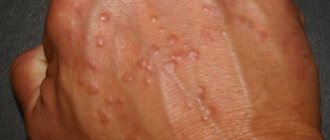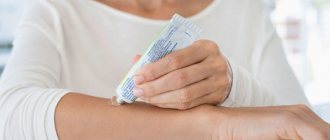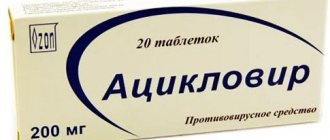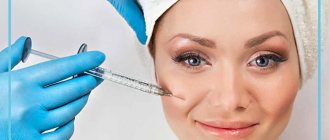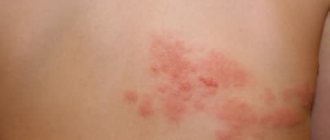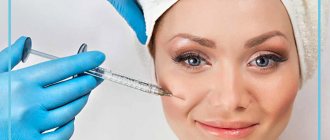Shingles or herpes is an infectious disease that causes damage to the skin with the appearance of characteristic rashes. The causative agent of the infection is the varicella zoster virus, which is in a latent state in the patient’s body.
After a person has had chickenpox, the virus becomes inactive and can persist in the cells of the spinal cord for decades. Its reactivation against the background of decreased immunity leads to the appearance of symptoms of herpes zoster.
What is shingles?
Shingles is a common viral disease diagnosed in people who have previously had chickenpox (chickenpox). The infection occurs more often in older people, which is associated with an age-related decrease in immune defense.
The development of shingles can be triggered by:
- uncontrolled medication use;
- radio and chemotherapy;
- hypovitaminosis;
- intense physical or mental stress;
- unfavorable environmental situation;
- prolonged exposure to allergens or toxic substances (for example, at work);
- a sharp change in climate zone;
- hypothermia of the body;
- chronic diseases, for example, diabetes, stomach ulcers;
- undergone surgical operations.
The risk of developing herpes zoster is higher among people suffering from autoimmune diseases and cancer.
The symptoms of the disease depend on its stage and the individual characteristics of the patient’s body. The incubation period can last decades, after which the virus is activated against the background of previous injuries, acute infections or other factors that weaken the immune system.
In a latent state, the pathogen is located in the spinal cord, but when the body’s defenses decrease, it begins to actively multiply and infect surrounding tissues. As a rule, the virus “moves” along the nerve endings to the skin, where it manifests itself in the form of a characteristic rash. At the same time, the infection spreads throughout the nervous system, including the brain, which causes attacks of pain and symptoms of general intoxication.
The first signs of shingles are:
- malaise and general weakness;
- increased fatigue;
- fever;
- headache;
- loss of appetite accompanied by nausea, in severe cases with vomiting.
After a few days, characteristic pain appears in the affected area of the skin. Painful sensations can be of varying intensity, intensify when touched, and be accompanied by itching.
In this case, the symptoms change, the following occurs:
- swelling and redness of tissues;
- rash in the form of reddish bubbles (vesicles) filled with liquid. The bubbles can grow and merge with each other.
After 3-5 days, the blisters shrink and disappear, often with the formation of scars.
Dermatologists distinguish several types of atypical shingles, in which the manifestations of the infection change:
- abortive - characterized by the absence of rash and pain, although the skin swells, but redness and swelling quickly disappear;
- bullous - instead of small blisters, the patient experiences large formations, and the symptoms of general intoxication intensify;
- hemorrhagic - the rash is filled with lymph with a large amount of blood, microhemorrhages occur in the skin, the pathological process affects the deep layers of the skin;
- gangrenous - deep and long-lasting ulcers appear at the site of the rash, the general condition of the patient is serious;
- generalized - the rash occupies up to half the body and can appear on the mucous membranes (for example, in the oral cavity).
The severity of the disease is directly related to the general state of the immune system. In older people, people suffering from severe chronic disorders, and those who have undergone radiation therapy, the infection is most acute and often leads to complications.
Herpes zoster and herpes-associated pain
Herpes zoster (HZ) is a sporadic disease that is the reactivation of a latent viral infection caused by the herpes virus type 3 (Varicella zoster virus (VZV)). The disease occurs with primary damage to the skin and nervous system.
VZV is the etiological agent of two clinical forms of the disease - primary infection (varicella) and its recurrence (herpes zoster). After a primary infection (chickenpox), usually in childhood or adolescence, the virus enters a latent state, localizing in the sensory ganglia of the spinal nerves. The commonality of the causative agent of chickenpox and herpes zoster was established even before the isolation of the virus using serological reactions in which liquid obtained from blisters on the skin of patients was used as an antigen. Later, using genomic hybridization, it was proven that in the acute period of herpes zoster, the detection rate of VZV is 70–80%, and in individuals without clinical manifestations, but with antibodies, viral DNA is detected in 5–30% of neurons and glial cells.
The prevalence of herpes zoster in different countries of the world ranges from 0.4 to 1.6 cases per 1000 patients/year in people under 20 years of age and from 4.5 to 11.8 cases per 1000 patients/year in older age groups. The lifetime risk of contracting herpes zoster is up to 20%. The main risk factor for its occurrence is a decrease in specific immunity to VZV, which occurs against the background of various immunosuppressive conditions.
Clinical picture of OH
The clinical picture of OH consists of skin manifestations and neurological disorders. Along with this, most patients experience general infectious symptoms: hyperthermia, enlarged regional lymph nodes, changes in the cerebrospinal fluid (in the form of lymphocytosis and monocytosis). Approximately 70–80% of patients with OH in the prodromal period complain of pain in the affected dermatome, which subsequently develops skin rashes. The prodromal period usually lasts 2–3 days, but often exceeds a week. Rashes with OH have a short erythematous phase, often completely absent, after which papules quickly appear. Within 1-2 days, these papules turn into vesicles, which continue to appear for 3-4 days - the vesicular form of herpes zoster. At this stage, elements of all types may be present on the skin. Elements tend to merge. Pustulation of vesicles begins a week or even earlier after the appearance of the first rash. After 3–5 days, erosions appear at the site of the vesicles and crusts form. If the period of appearance of new vesicles lasts more than one week, this indicates the possibility of an immunodeficiency state. The crusts usually disappear by the end of the 3rd or 4th week. However, peeling and hypo- or hyperpigmentation may remain for a long time after the resolution of OH.
Pain syndrome is the most painful manifestation of OH. While some patients experience rash and pain of relatively short duration, 10–20% of patients experience postherpetic neuralgia (PHN), which can last months or years, significantly reduces quality of life, causes great distress, can lead to loss of independence, and is associated with significant financial costs . Effective treatment of pain associated with OH is an important clinical goal.
Herpes-associated pain
According to modern concepts, pain syndrome in OH has three phases: acute, subacute and chronic. If in the acute phase the pain syndrome is mixed (inflammatory and neuropathic) in nature, then in the chronic phase it is typical neuropathic pain (Fig.). Each of the listed phases has its own treatment features, based on the pathogenetic mechanisms of pain and confirmed by controlled clinical studies.
Acute herpetic neuralgia
Pain in acute herpetic neuralgia usually occurs in the prodromal phase and lasts for 30 days - this is the time required for the rash to resolve. In most patients, the appearance of a rash is preceded by a burning sensation or itching in a specific dermatome, as well as pain, which can be stabbing, pulsating, shooting, paroxysmal or constant. In a number of patients, the pain syndrome is accompanied by general systemic inflammatory manifestations: fever, malaise, myalgia, headache. Determining the cause of pain at this stage is extremely difficult. Depending on its location, differential diagnosis should be made with angina pectoris, intercostal neuralgia, acute attack of cholecystitis, pancreatitis, appendicitis, pleurisy, intestinal colic, etc. The cause of the pain syndrome becomes obvious after the appearance of characteristic rashes. In typical cases, the prodromal period lasts 2–4 days, no more than a week. The interval between the onset of the prodrome and the onset of rash is the time required for reactivated VZV to replicate in the ganglion and be transported along the cutaneous nerve to nerve terminals at the dermoepidermal junction. The replication of the virus in the skin takes some more time, followed by the formation of inflammatory reactions. The immediate cause of prodromal pain is subclinical reactivation and replication of VZV in neural tissue. Experimental studies on animals have shown that at sites of VZV replication, the concentration of neuropeptide Y in nervous tissue, which is a marker of neuropathic pain, increases [1]. The presence of severe pain in the prodromal period increases the risk of more severe acute herpetic neuralgia and the likelihood of subsequently developing postherpetic neuralgia.
In most immunocompetent patients (60–90%), severe, acute pain accompanies the appearance of a skin rash. The severity of acute pain syndrome increases with age. Severe pain is also observed more often in women and in the presence of a prodrome. A characteristic feature of acute herpetic neuralgia is allodynia - pain caused by a non-painful stimulus, such as the touch of clothing. It is allodynia in the acute period that is a predictor of the occurrence of postherpetic neuralgia [2, 3]. The absence of allodynia, on the contrary, is a good prognostic sign and may suggest recovery within three months.
Subacute herpetic neuralgia
The subacute phase of herpetic neuralgia begins after the end of the acute phase and lasts until the onset of postherpetic neuralgia. In other words, this is pain that lasts more than 30 days from the beginning of the prodrome and ends no later than 120 days (Fig.). Subacute herpetic neuralgia can develop into postherpetic neuralgia. Factors predisposing to the continuation of pain include: older age, female gender, the presence of a prodrome, massive skin rashes, localization of rashes in the area of innervation of the trigeminal nerve (especially the eye area) or brachial plexus, severe acute pain, the presence of immunodeficiency [3, 4 ].
Postherpetic neuralgia
The International Herpes Treatment Forum defines PHN as pain lasting more than four months (120 days) after the onset of the prodrome. PHN, especially in older patients, can last for many months or years after the rash has healed. With PHN, three types of pain can be distinguished: 1) constant, deep, dull, pressing or burning pain; 2) spontaneous, periodic, stabbing, shooting, similar to an “electric shock”; 3) pain when dressing or lightly touching in 90%.
Pain syndrome is usually accompanied by sleep disturbances, loss of appetite and weight loss, chronic fatigue, and depression, which leads to social isolation of patients.
PHN is considered to be a typical neuropathic pain resulting from damage or dysfunction of the somatosensory system. Several mechanisms are involved in its pathogenesis.
- Nerve damage disrupts the transmission of pain signals, which leads to increased activity of higher order neurons (deafferentation hyperalgesia) [6–8].
- Nerve fibers damaged by VZV may generate spontaneous activity at the site of injury or other sites along the nerve (spontaneous ectopic activity of injured axons).
- Damage or inflammation of the nerve as a result of virus reactivation leads to a decrease in the threshold for activation of nociceptors, activation of urinary nociceptors—peripheral sensitization [5, 9].
- As a result of these changes in the peripheral parts of the somatosensory system, the activity of central nociceptive neurons increases and new connections are formed between them, provided that the pain continues—central sensitization [10–12]. The systems for recognizing pain and temperature stimuli are characterized by increased sensitivity to minor mechanical stimuli, causing severe pain (allodynia).
In most patients, pain associated with PHN improves within the first year. However, in some patients it can persist for years and even throughout the rest of their lives, causing considerable suffering. PHN has a significant negative impact on the quality of life and functional status of patients, who may develop anxiety and depression.
How to reduce the risk of PHN?
This issue is the most important for any doctor treating a patient with OH, and includes early initiation of etiotropic (antiviral) therapy and adequate pain relief in the acute stage.
Antiviral therapy. The results of many clinical studies have shown that the administration of antiviral drugs reduces the period of viral shedding and the formation of new lesions, accelerates the resolution of the rash and reduces the severity and duration of acute pain in patients with OH. Thus, in controlled studies using recommended dosages, the time to complete cessation of pain when prescribing famciclovir was 63 days, and when prescribing placebo - 119 days. Another study showed greater effectiveness of valacyclovir compared to acyclovir: pain syndrome when prescribed valacyclovir (Valavir) disappeared completely after 38 days, and when prescribed acyclovir after 51 days. Valacyclovir and famciclovir have similar effects on herpes-associated pain in immunocompetent patients [13, 23]. Thus, antiviral therapy is indicated not only for the rapid relief of skin manifestations, but also for the acute phase of the pain syndrome.
In all controlled clinical trials of antiviral therapy (
) it is recommended to start therapy within 72 hours of the onset of rash [1, 14].
The effectiveness of the anti-pain effect of antiviral therapy started at a later date has not been systematically studied, however, numerous clinical data suggest that late-started therapy can also affect the duration and severity of acute pain.
Antipain therapy. Effective relief of acute pain syndrome in OH is the most important stage in the prevention of PHN. It is advisable to stage-by-stage treatment of zoster-associated pain syndrome in all its phases. Thus, in the treatment of acute and subacute herpetic neuralgia, pain therapy consists of three main stages:
- Stage 1: Aspirin, paracetamol, non-steroidal anti-inflammatory drugs (NSAIDs);
- Stage 2: opioid analgesics, including tramadol;
- Stage 3: drugs with a central analgesic effect (tricyclic antidepressants, anticonvulsants).
Considering that in our country there are known organizational difficulties in prescribing opioid analgesics, if simple analgesics and NSAIDs are insufficiently effective, it is necessary to move on to prescribing drugs with central action.
Treatment of postherpetic neuralgia
Currently, there are 5 main groups of medications: anticonvulsants, tricyclic antidepressants, lidocaine patch, capsaicin, opioid analgesics [21].
Anticonvulsants: Gabapentin and pregabalin are the two most commonly used anticonvulsants for the management of neuropathic pain associated with PHN. Drugs are more often used at the beginning of the development of PHN to reduce the acute component of neuropathic pain. In one study [15], in patients taking gabapentin, 43.2% had a decrease in pain perception, compared with 12.1% in the placebo group. In a similar trial [16], pregabalin also reduced the number of patients with PHN, especially in those aged 65 years and older. Gabapentin and pregabalin appear to be equally effective in reducing neuropathic pain [17]. Gabapentin is the drug of first choice for the treatment of any type of neuropathic pain; it is one of the most well-studied and widely used drugs in neurologist practice for the relief of pain in PHN. It is a structural analogue of gamma-aminobutyric acid (GABA). Gabapentin enhances the synthesis of GABA by stimulating the activity of glutamate decarboxylase; modulates the activity of NMDA receptors; blocks a-2-d-subunits of voltage-dependent calcium channels and inhibits the entry of Ca2+ into neurons; reduces monoamine release and sodium channel activity; reduces the synthesis and transport of the excitatory neurotransmitter glutamate; helps reduce the frequency of action potentials in peripheral nerves. The concentration of gabapentin in the blood plasma reaches its peak 2–3 hours after administration, the half-life is 5–7 hours. The dosing interval should not exceed 12 hours, bioavailability is 60%. Eating does not affect the pharmacokinetics of the drug; antacids reduce its concentration in the blood, so gabapentin should be taken no earlier than 2 hours after taking antacids. Excreted in breast milk; The effect of the drug on the child’s body has not been studied. Adverse reactions develop extremely rarely: slight dizziness, drowsiness. Gabapentin enhances the effect of lidocaine and antidepressants. You should refrain from combining it with alcohol, tranquilizers, antihistamines, barbiturates, sleeping pills, and drugs. The drug has important advantages in the treatment of neuropathic pain: safety, low potential for interaction with other drugs, good tolerability, and is not metabolized in the liver. Gabapentin is the drug of choice for the treatment of elderly people during polypharmacotherapy; it is convenient to use and has been proven to be highly effective.
Gabapentin dosage regimen. Initial dose: 1st day 300 mg in the evening; 2nd day 300 mg 2 times (day and evening); Day 3: 300 mg 3 times. Titration: days 4–6 300/300/600 mg; 7–10 days 300/600/600 mg; Days 11–14 600/600/600 mg. Daily therapeutic dose 1800–3600 mg, maintenance dose 600–1200 mg/day.
Pregabalin has a mechanism of action similar to gabapentin, but does not require slow titration and is therefore more convenient for clinical use. The drug is prescribed twice a day. The initial dose is 75 mg twice, the daily therapeutic dose is 300–600 mg. Several randomized clinical studies of the effectiveness of pregabalin in postherpetic neuralgia have been conducted, which showed the rapid development of an analgesic effect (during the first week of administration), good tolerability, ease of use and a reduction in sleep disturbances associated with pain [22].
Antidepressants. Drugs in this group, especially tricyclics (nortriptyline and amitriptyline), are important components in the treatment of pain in PHN. Due to the activation of descending serotonin and norepinephrine antinociceptive systems and the ability to block sodium channels, antidepressants block the perception of pain. In clinical trials of the effectiveness of tricyclic antidepressants in reducing pain in PHN, 47% to 67% of patients reported “moderate to excellent” pain relief, with equivalent effects reported for amitriptyline and nortriptyline [17]. However, nortriptyline does not cause many anticholinergic effects and may therefore be preferable to amitriptyline.
A patch with 5% lidocaine is applied to the affected area at the beginning of chronic pain or immediately after the diagnosis of PHN is made. The patch is applied to intact, dry, non-inflamed skin. It is not used on inflamed or damaged skin (i.e. during active herpetic eruptions). Lidocaine is an antagonist of sodium ion channels, the analgesic effect develops as a result of preventing the generation and conduction of neuronal activity potentials, by binding sodium channels of overactive and damaged nociceptors. A patch with 5% lidocaine has a local effect and has almost no systemic effects. Several studies have shown that the lidocaine patch reduces pain compared with placebo [18]. Comparative studies of the effectiveness of 5% lidocaine and pregabalin showed their equal effectiveness [19]. Capsaicin, which is made from red peppers and is an irritant, is used as an ointment or patch. When applied to the skin, it depletes peptidergic neurotransmitters (eg, substance P) in primary nociceptive afferents. The drug should be applied to the affected area 3-5 times a day to maintain a long-term effect. Despite the fact that a number of studies have shown the effectiveness of capsaicin against PHN, many patients often experienced significant adverse reactions: for example, a third of patients reported the development of an “unbearable” irritant effect of the drug, which significantly limits its clinical use in PHN.
Opioid analgesics (oxycodone, methadone, morphine) can also be used in the treatment of PHN. They reduce neuropathic pain by binding to opioid receptors in the central nervous system or inhibiting the reuptake of serotonin or norepinephrine at peripheral nerve endings - nerve synapses. According to research results, oxycodone, compared with placebo, provides greater pain relief and reduces the severity of allodynia, but causes the development of adverse reactions such as nausea, constipation, drowsiness, loss of appetite, and drug dependence [20]. Comparative studies of the effectiveness of opioids and tricyclic antidepressants have demonstrated their equivalent effectiveness.
In the section “Treatment of postherpetic neuralgia” in the 2009 European guidelines [21] for the treatment of neuropathic pain, first-line therapy is distinguished (drugs with proven effectiveness - class A): pregabalin, gabapentin, lidocaine 5%. Second-line drugs (class B): opioids, capsaicin.
When treating patients with PHN, it is advisable to follow certain steps.
Initially, first-line drugs are prescribed: gabapentin (pregabalin), or TCAs, or local anesthetics (plates with 5% lidocaine). If it is possible to achieve good pain reduction (VAS pain score – 3/10) with acceptable side effects, then treatment is continued. If pain relief is not sufficient, another first-line drug is added. If first-line drugs are ineffective, second-line drugs can be prescribed: tramadol or opioids, capsaicin, non-pharmacological therapy. In the complex therapy of postherpetic neuralgia, non-pharmacological therapy is also used: acupuncture, TENS anesthetic device, the most promising and effective method is neurostimulation.
Treatment of PHN is extremely challenging. Even with the use of various pain medications and referral to a specialist algologist, it is not always possible to achieve the disappearance of the pain syndrome.
Literature
- Dworkin RH Johnson RW, Breuer J., Gnann JW, Levin MJ Recommendation for management of herpes zostritis // Cln Infec Dis. 2007; 44: (Supl 1): S1–S26.
- Dworkin RH, Nagasako EV, Johson RW, Griffin DR Acute pain in herpes zoster: tue famciclovir database project // Pain. 2001; 94: 113–119.
- Hope-Simpson RE Postherpetic neuralgia // JR Coll Gen. Pract. 1975; 157:571–675.
- Choo P., Galil K., Donahue JG Walker et al. Risk factors for postherpetic neuralgia // Arch. Intern. Med. 1997; 157:1217–1224.
- Garry EM, Delaney A, Anderson HA et al. Varicella oster virus induces neuropathic changes in rat dorsal root ganglia and behavior reflex sensitization that is attenuated by gabapentin or sodium channel blocking drugs // Pain. 2005; 118:97–111.
- Yung BF, Johnson RW, Griffin DR, Dworkin RH Risk factors for postherpetic neuralgia in patients with herpes zoster // Neurology. 2004; 62:1545–1551.
- Jonson RW Zoster-associated pain: what is know, who is at risk and how can it be managed? // Herpes. 2001, 14 Supplement; 2:31A–34A.
- Tal. M., Bennett GJ Extra territoiral pain in rats with a peripheral mononeuropathy: mechano-hyperalgesia and mechano-allodenia in the territory of an uninjured nerve // Pain. 1994; 57:375–382.
- Oaklander AL The density of remaining nerve endings in human skin with and without postherpetic neuralgia after shingles // Pain. 2001; 92: 139–145.
- Rowbotham MC, Yosipovitch G., Connoly MK, Finlay D., Forde G., Fields HL Cutaneus innervation density in allodynic from postherpetic neuralgia // Neurobiol. Dis. 1996; 3:205–214.
- Rowbotham MC, Fields HL The relationship of pan, allodynia and thermal sensation in post-herpetic neuralgia // Brain. 1996; 119(Pt2):347–354.
- Scholz J., Broom DC, Youn DH, Mills CD, Kohno T. et al. Blocking caspase activity prevents transsynaptic neuronal apoptosis and the loss of inhibition in lamina 11 of dorsal horn afer peripheral nerve injury // J Neurosci. 205; 25:7317–7323.
- Tyring SK, Beutner KR, Tucker BA et al. Antiviral therapy for herpes zoster. Randomized, controlled clinical trial of vlacyclovir, and farmavir therapy in immunocompetent patients of 50 years and older // Arch Farm Med. 2000; 9:863–869.
- Gross G., Schofer H. et al. Herpes zoster guideline of German Dermatology Society (DDG) // J of Clinical Virology. 2003; 26:277–289.
- Rowbotham M., Harden N., Stacey B. et al. Gabapentin for the treatment of postherpetic neuralgia: a randomized controlled trial // JAMA. 1998. Vol. 280. P. 1837–1842.
- Dworkin R., Young J., Sharma U. et al. Pregabalin for the treatment of postherpetic neuralgia: a randomized, placebocontrolled trial // Neurology. 2003. Vol. 60. P. 1274–1283.
- Stankus S., Dlugopolski M., Packer D. Management of herpes zoster (shingles) and postherpetic neuralgia // Am Fam Physician. 2000. Vol. 61. P. 2437–2444.
- Karly P. Garnock-Jones, Gillin M. Keating/Lidocain 5% Medical Plaster. A review of its use in hjsterpetic neuralgia // Drugs. 2009; 69(15):2149–2165.
- Rehm S., Binder A., Baron R. Post-herpetic neuralgia: 5% lidocain medicated plaster? Pregadflin, or a combination both? A randomized, open/clinical effectiveness study // Cur. Med. Reas. 2010, v. 26, no. 7.
- Watson C., Babul N. Efficacy of oxycodone in neuropathic pain: a randomized trial in postherpetic neuralgia // Neurology. 1998. Vol. 50. P. 1837–1841.
- Attal N. et al. EFNS guidelines of the pharmacological treatment of neuropathic pain: 2009 revision // European Journal of Neurology. 2010.
- Seventer R., Feister H. et al. Efficacy and tolerance of twice-daily pregabalin for treating pain and related sleep interference in postherpetic neuralgia: a 13-week, randomized trial // Curr Med Res Opin. 2006; 22 (2): 375–384.
- Beutner KR et al. Valaciclovir compared with acyclovir from improved therapy for herpes zoster in immunocompetent adults // Antimicrobal agents and chemotherapy. 1995, July, vol. 37, no. 7, p. 1546–1553.
E. G. Filatova, Doctor of Medical Sciences, Professor First Moscow State Medical University named after. I. M. Sechenova, Moscow
Contact information about the author for correspondence
Table.
How is shingles transmitted?
You can get shingles from someone who has herpes or chickenpox. However, if the patient comes into contact with this virus for the first time, he will get chickenpox, and not shingles. The appearance of lichen is possible only in the case of a secondary lesion.
Most often, the pathogen is transmitted by airborne droplets; contact infection is also possible.
When the virus is inhaled, it remains in the respiratory tract and begins to spread throughout the body along with the flow of lymph and blood, as well as moving along nerve endings. Gradually, the pathogen penetrates most tissues of the body. This explains the recurrent nature of herpes zoster - it is impossible to suppress the virus with self-medication; complex therapy is required under the supervision of an experienced dermatologist.
Painkillers
During the appearance of rashes, the herpes virus attacks the myeloid sheath of the nerve endings. That is why nerve impulses travel not only along the nerve core, but also spread throughout the body. As a result, the patient, when affected by herpes zoster, experiences acute pain. The pain syndrome, even after the disappearance of external manifestations of the viral infection, can persist for up to a month. This continues until the nerve endings restore myelin.
To reduce the pain of herpes zoster, as well as to relieve postherpetic syndrome, patients are prescribed painkillers. In this case, they have a good analgesic effect:
- Non-steroidal anti-inflammatory drugs
. These medications include Ibuprofen, Ketorol, Nimesulide. These drugs effectively relieve pain while simultaneously providing an antipyretic effect. All such medications are available in several dosage forms: syrup, powder, tablets. - Antidepressants
. This type of drug helps to cope with the depressed state that is provoked by the herpes virus. They help reduce the severity of pain and relax muscles. They are most often used in the complex therapy of herpes zoster. - Anticonvulsants
. They can be prescribed for extensive herpes lesions that have a serious effect on the nervous system. - Novocaine blockades
. This procedure helps relieve acute pain and reduce muscle spasms. Prescribed periodically for severe pain syndrome.
The prescription of painkillers is necessary in case of severe disease in order to avoid the development of chronic pain syndrome. In this case, medications are prescribed on an individual basis.
What does shingles look like?
One of the hallmarks of shingles is a specific pink rash that appears on the face and body. Vesicles appear on the 3rd-4th day of infection, they are preceded by:
- pain and burning of the skin;
- tissue redness;
- slight swelling of the skin.
Then one or more small pink-red bubbles with transparent contents appear. In most cases, the size of the rash does not exceed a pea; small bubbles can merge into larger formations.
After a few days, the contents of the bubbles become cloudy, they burst with the formation of a yellow-brown film. Vesicles do not appear all at once and continue to form over several days, occupying an increasing area of the body.
After recovery, patches of skin with disturbed pigmentation, scars and scar tissue often form at the site of the rash.
Where does shingles occur?
The location of the rash depends on which nerve is affected. The rash may appear on the face, torso, and limbs, but usually only on one side of the body: for example, only on the back or only on the stomach. If vesicles appear on both sides, this indicates a rare generalized form of herpes zoster.
The rash may also affect:
- ears;
- mucous membrane of the mouth and nose;
- conjunctiva of the eyes;
- external genitalia, including the vulva in women.
If bubbles appear on the mucous membranes, they quickly burst with the formation of areas of erosion.
Features of therapy in pregnant women
Treatment of herpetic infection in women bearing a child is carried out using drugs that do not have a negative effect on the pregnant woman and the fetus. In most cases, these are drugs for external use, from the antiviral group. Interferon may be prescribed to support the immune system. From the second trimester it can be used in the form of suppositories.
Vitamin and mineral complexes can also be added to the therapy complex.
During pregnancy, herpes zoster can only be treated in a hospital setting.
If shingles occurs in the prenatal period, there is a risk of infection of the unborn child. In this case, pathogenic microorganisms will lead to the development of chickenpox in the newborn. At such an early age, pathology threatens the development of severe damage to the liver, kidneys, lungs, and nervous system. Diseases of this etiology are treated by an infectious disease specialist and a neonatologist.
Which doctor treats shingles?
A dermatologist treats shingles.
At the appointment, the doctor visually assesses the condition of the skin, after which he may prescribe additional tests, including:
- general analysis of urine and blood;
- polymerase chain reaction (PCR);
- blood biochemistry;
- serological analysis.
Based on the results of the examination, the dermatologist prescribes appropriate treatment.
How is shingles treated?
Treatment tactics largely depend on the severity of herpes zoster, the patient’s age, and his state of health. Properly selected therapy can significantly reduce recovery time, eliminate unpleasant symptoms, avoid complications and suppress the virus. In most cases, the basis of treatment is taking the following set of medications:
- antiviral drugs – suppress the growth and reproduction of the herpes virus;
- non-steroidal anti-inflammatory drugs – fight high fever, improve overall well-being;
- immunomodulators – activate the body’s own defenses, which also contributes to a speedy recovery;
- antihistamine tablets - relieve swelling of the skin, reduce itching.
To suppress bacterial growth in sores, your dermatologist may prescribe antibiotics along with probiotics. Local remedies are also used: antiviral ointments, hydrogen peroxide solution, and other antiseptics. They gently treat the affected areas of the skin.
Ointments have a complex effect: they suppress the virus inside the vesicles, accelerate the healing of the skin, and minimize the risk of infection of ulcers by bacteria. Local remedies also relieve swelling and redness of tissues and eliminate itching.
For a quick recovery without relapse, it is important to eliminate the cause of shingles. If it is caused by hypovitaminosis, multivitamin complexes and ascorbic acid are prescribed; in case of stress, it is necessary to normalize the daily routine and get proper rest. It is important to follow a balanced diet: reduce the consumption of animal fats, give up salty and smoked foods, add more fresh vegetables to the diet.
Treatment tactics should be determined by a dermatologist - self-medication will not lead to results, and can aggravate the course of herpes zoster and increase the risk of complications. If you consult a doctor in a timely manner and follow his recommendations, the prognosis in most cases is favorable.
Antiviral drugs
Various antiviral agents will help slow down viral activity, as well as stop the vital activity of pathogens in the described disease. The most effective of them are recognized:
- Acyclovir
. The drug is available in three forms: ointment, eye drops and tablets. The active component, acyclovir, acts at the cellular level. It restores pathogen-damaged cell DNA. The average course of treatment is 7-14 days. After consulting a doctor, longer use is possible. - Fenistil Pencivir
. The drug is available in the form of a gel for topical use. Quickly reduces swelling, hyperemia, helps heal the skin. In addition, the product has an antiviral and immunomodulatory effect. - Famvir
. The active ingredient is Famciclovir. The drug reduces the severity of postherpetic neuralgia. The average course of therapy is 7-8 days. - Panavir
. A powerful antiviral agent with an immunomodulatory effect. Not approved for use in children, as well as pregnant and lactating women. Available in the form of a gel and injection solution. - Hyporamine
. The medicine is developed on a plant basis. Has an antiviral and healing effect. With a mild form of the disease, recovery occurs within 7 days. For more severe cases, treatment continues for up to three weeks. - Viferon
. The drug is produced in several dosage forms: in the form of gels, ointments and suppositories for rectal use. It has strong antiviral activity, helps the synthesis of its own interferon, increasing the immune response to the pathogenic pathogen. The therapeutic course is 5-7 days. During this period, the main symptoms of herpes zoster disappear. - Vectavir
. The drug reduces the activity of viruses that enter the body by destroying their own DNA. Remains inside infected cells for up to 12 hours, thereby stopping the spread of the infectious process. - Isoprinosine
. The drug blocks almost all types of viral infections. The course of treatment compared to other means is quite long and lasts about 2-3 weeks. Contraindication to the use of isoprinosine is children under 3 years of age.
In severe cases of the disease, as well as in elderly patients whose immune function is reduced, antiviral drugs are prescribed in tablet or injection form. External preparations are used only at the first skin manifestations.
How to relieve the pain of shingles?
Sharp, severe pain in the affected nerves is one of the key symptoms of shingles. To alleviate them, the dermatologist prescribes analgesics, which must be taken strictly in the prescribed dosage. If pain is very bothersome to the patient, opioid medications may be prescribed.
If the herpes virus severely damages the nerve endings, the patient develops postherpetic neuralgia. In this case, the pain does not go away even after complete recovery - the person continues to be bothered by sharp pain attacks.
Postherpetic neuralgia may be accompanied by:
- numbness of the skin at the site of the rash;
- painful itching;
- feeling of "goosebumps".
In this case, the doctor prescribes antidepressants and anticonvulsants. The risk of postherpetic neuralgia increases in elderly patients, people with HIV infections, and also in cases where the patient started treatment late and did not adhere to medical prescriptions.
Can shingles be washed?
During illness, due to damage to the skin, patients are prohibited from taking a bath or shower, or visiting a sauna or swimming pool. At the same time, it is important to continue to maintain personal hygiene, otherwise the risk of infection of the vesicles with bacterial flora increases.
Therefore, dermatologists recommend:
- regularly use antiseptic ointments and solutions to treat rashes;
- change underwear daily;
- update bed linen with antiseptic treatment - washing at high temperatures and ironing.
It is necessary to avoid synthetic, tight and dense clothing that interferes with skin respiration and can damage the vesicles. After all the bubbles have dried, you can resume normal hygiene procedures, and also take salt baths as an additional method of therapy in consultation with your doctor.
How long does it take to treat herpes zoster?
The patient’s recovery time depends on his age and individual characteristics of the body. Shingles is most easily transmitted by young people under the age of 35-40 years. But even in elderly patients, with properly selected treatment, the virus is suppressed within 5 weeks.
However, in some cases the infection leads to various complications:
- bacterial skin infection is the most common complication, usually resulting from poor personal hygiene. After the vesicles dry, the ulcer becomes infected with a bacterial pathogen, which leads to an acute inflammatory reaction and suppuration;
- postherpetic neuralgia is also a common complication, more often diagnosed in old age. In this case, symptoms of shingles may persist for up to six months.
Rarer types of complications include:
- pneumonia;
- nerve paresis;
- glaucoma and other ophthalmological disorders;
- meningoencephalitis and other central nervous system lesions.
To avoid complications, it is recommended to consult a doctor at the first signs of the disease. Since the initial symptoms of shingles (fatigue, fever, body aches) can be confused with the flu or a cold, patients often turn to a general practitioner, who involves a dermatologist in treatment.
How long is shingles contagious?
A person with shingles is contagious to others. The virus is in active form 1-2 days before the rash appears and until the vesicles have completely healed. To limit the spread of infections, during this period the patient is advised to avoid contact with other people,, if possible, limit communication with friends and relatives, and not use shared utensils or hygiene products.
After the rash goes away, shingles ceases to be dangerous for people around you - the immune system has suppressed the viral infection.
Herpes
The content of the article
Herpes, caused by herpes virus I or II, is one of the most common infectious diseases in humans.
There are two types of viruses:
- type I is most often associated with infection in the facial area;
- type II with localization of genital lesions.
After primary infection, both types of viruses remain latent in the ganglia. Due to a variety of factors that contribute to the development of infection, viruses can travel along nerves and multiply in the skin or mucous membranes, causing symptoms of the disease.
In carriers of active infection without symptoms, HSV viruses can be detected in saliva and vaginal discharge. This can lead to the spread of infections, especially HSV2. Infection occurs through personal contact or contamination with secretions.
Primary HSV1 infection occurs in young children and is often asymptomatic or in the form of stomatitis. It turned out that with high population density and poor housing conditions, 100% of children under five years old have antibodies to HSV1.
Primary HPV2 infection occurs after puberty, most often through sexual contact. Its consequence is always skin symptoms in the genital area. Rarely, HSV1 infection can occur in the genital area, most often due to infection during oral sex.
HSV1 or HSV2 infection in children in the genital area may result from sexual abuse.
Patients with a history of HSV infection have circulating serum antibodies that do not protect against recurrence of infection.
